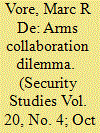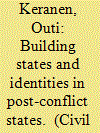| Srl | Item |
| 1 |
ID:
109073


|
|
|
|
|
| Publication |
2011.
|
| Summary/Abstract |
One of the most dramatic developments in the field of armaments has been the rise of international collaboration over the last several decades. Nowhere has this phenomenon been more pronounced than the domain of military aircraft, where few states possess the resources to remain autonomous. Surprisingly, despite the theoretical advantages of interoperability and economies of scale, armaments collaboration has rarely, if ever, proven efficient. This article examines how states have employed governance structures, over time, to improve the collaborative process. To preview the conclusion, a stark trade-off exists between states' ability to control principal-agent dynamics and minimize collective action problems. Consequently, the dilemma of armaments collaboration is that any attempt to address principal-agent dynamics will aggravate collective action problems and vice-versa. With this in mind, it may be futile to continue reforming armaments collaboration because any governance structures will result in a deleterious combination of principal-agent dynamics and collective action problems.
|
|
|
|
|
|
|
|
|
|
|
|
|
|
|
|
| 2 |
ID:
133578


|
|
|
|
|
| Publication |
2014.
|
| Summary/Abstract |
An integral part of state formation processes is identity-building: 'making one out of many' as Walzer puts it. This is also true in terms of contemporary, internationally led statebuilding projects. This dimension of international statebuilding is important, as fundamental questions pertaining to belonging are as important to successful post-conflict process as institutional arrangements; in fact, assumptions about identities and group boundaries guide the technical decisions on institutional and governance structures. The central aim of this paper is to reflect upon identity-construction as a part of post-conflict statebuilding through exploring how historical and more recently invented symbols are deployed to construct a specific sense of belonging. The analysis finds a multiplicity of identity-building projects that advance different visions of community and belonging. The outcome is politicised and contentious visual, everyday landscape that legitimises competing local statebuilding projects (grounded in the distinctions between Bosnian peoples), while undermining peacebuilding and reconciliation. Yet, rather than indicating a primordial antagonisms or incompatible 'liberal' and 'local' norms, the conflicts over symbols (and ultimately, identities) between international and local agents are indicative of wider disagreements over how the Bosnian state ought to be organised and are fuelled by the institutional structures of the country and the weaknesses in the international statebuilding
|
|
|
|
|
|
|
|
|
|
|
|
|
|
|
|